![]() 1st Battalion 22nd Infantry
1st Battalion 22nd Infantry ![]()
Corporal Elmore Nelson
Brothers-in-arms of Company H
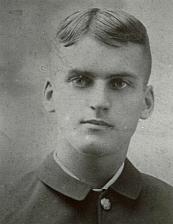
Elmore Nelson
Photo taken as a member of Company H 22nd Infantry 1896-1899
Courtesy of William Bosque
The following story of Corporal
Elmore Nelson, Company H 22nd US Infantry
was put together by his grandson William Bosque and his
grandaughter Teresa Howes.
Additional material added by the website editor.
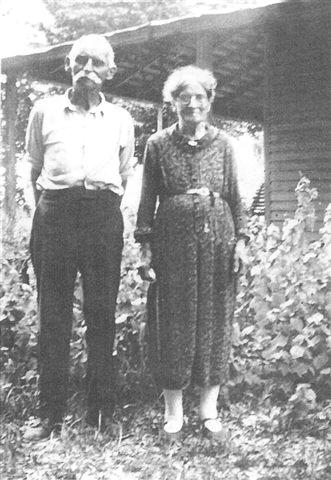
Alex Nelson and Caroline Philpott Nelson the parents of Elmore Nelson
Courtesy of William Bosque
(Website Ed., : Elmore Nelson
was born in St Thomas, Elgin, Ontario, Canada on September 30,
1878 to Alex and Caroline Nelson.
Though he was born in Canada his parents were American citizens
therefore Elmore was also an American citizen.
Elmore enlisted as a Private in the United States Army for a
period of three years on September 10, 1896 at Detroit, Michigan.
His recruiting officer was Captain Benjamin C. Lockwood,
Commanding Officer of Company D 22nd Infantry who was in
Detroit on Detached Service of Recruiting Duty. Nelson's
enlistment record indicated he stood 5 feet 8 ¼ inches tall, had
blue eyes, dark brown hair and a fair complexion. His previous
occupation was listed as Farmer. He was assigned to
Company H 22nd Infantry at Fort Crook, Nebraska on September 13,
1896.)
Elmore Nelson, a US soldier, served in Company
H of the 22nd Infantry Regiment, a combat regiment that was
always in the field and on the offensive.
On the 18th April, 1898, he departed by rail from Fort Crook,
Nebraska, under the command of Charles A Wikoff and arrived on
the 20th
in Mobile, Alabama. War between Spain and the USA was declared on
the 25th April 1898.
The Regiment was assigned to the Fifth Army,
First Brigade, 2nd Division under Major General William R
Shafter. It left Mobile on the 28th April
arriving in Tampa Florida on the 2nd May. The commanding general
realised that the army was not ready for a campaign in the
tropics.
The troops were all in heavy winter uniforms, which they were
forced to wear throughout the Cuban action,
as there was no time for them to be issued with uniforms more
suited to the tropics.
On the 14th of June, they boarded the vessel
Orizaba and sailed for Santiago, Cuba. Six days later, they
arrived at Morro Castle,
which is the entrance to Santiago Bay. Lt Colonel John Patterson
was placed in command.
They landed at Daiquiri and it was the first regiment to land in
Cuba.
The small boats ferried them to shore in very
choppy waters, so that the men were drenched. Each man carried a
blanket, poncho
and 3 day’s rations all rolled up in a shelter tent. They
marched through the choking dust which turned into mud on their
sopping wet uniforms.
The sun bore down, so the men threw away blankets, clothing,
haversacks and even their rations. Conditions were grim.
The next morning they took possession of Siboney.
On the 1st July, General Ludlow approached El
Caney. Fierce battles ensued through overgrowth and jungles.
They were one day battles with many casualties. The most famous
of these battles is called the Battle of San Juan Heights.
The soldiers slept alongside the muddy roadway. The troops
withstood the lengthy siege of the Spanish, but being crouched in
trenches,
knee deep in water, short of rations, battling the insects and
very hot weather, they were easy prey to tropical diseases.
Elmore Nelson saw combat. He saw men shot down all around him.
Dysentery, malaria and other tropical diseases spread throughout
the Regiment.
Elmore contracted both malaria and dysentery. On the 17th, the
Regiment entered Santiago.
Out of 513 officers and men, only 165 were left and almost all
were suffering from disease and malnutrition.
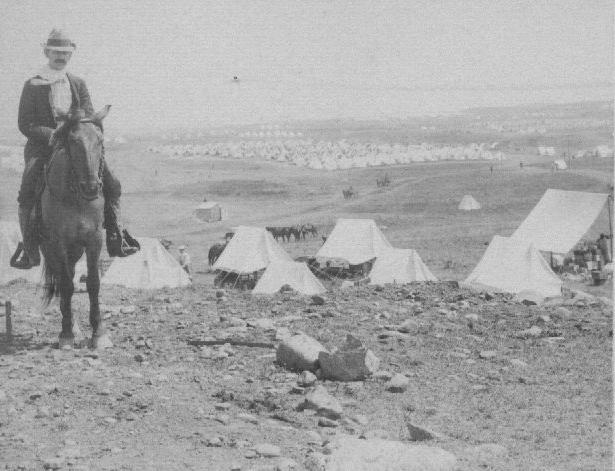
Montauk Point - Camp Wikoff - 1898
These men were returned to the US on the 11th
August, 1898, and sent to Montauk Point, New York.
This is at the extreme end of Long Island to a receiving station
called Camp Wikoff in honour of Colonel Charles A.Wikoff,
former Commander of the 22nd Infantry Regiment, who had died in
battle.
Elmore arrived there both physically ill and mentally exhausted.
They arrived on the 20th and were issued their
summer uniforms, but then sharp sea breezes and colder weather
was settling in.
Conditions at Camp Wikoff were not good. There were too many
patients and not enough doctors, nurses or medicines.
Now Elmore was hospitalised in a Boston Hospital and from there
spent time on a sick furlough, with his parents in Mount Morris,
Michigan
in the month of October, 1898. From there he was sent to Camp
Crook, Nebraska. Four months of intensive training
and 4 additional companies were authorized bringing the strength
of the Regiment to 26 officers and 1070 enlisted men.
Jacob Kreps was appointed commanding officer.
The 22nd Infantry Regiment was issued orders on
the 27th January 1899 to proceed to California by rail for
embarkation to the Philippines.
Although one of the provisions of the Treaty of Paris was that
the Philippines was ceded to the USA by Spain,
the Filipinos believed that they would govern themselves and so
tried to establish their own government under Aguinaldo.
The US would not agree to this, so the Philippine-American War,
or Philippine Insurrection began on the 4th February 1899.
This war coming so soon after the Spanish American War did not
allow sufficient time to recuperate.
Therefore, Elmore entered the Philippines with a very low power
of resistance. After 5 months of marching, fighting and pushing
bull carts in tropical weather,
he felt pains in his left groin and had to be hospitalised in the
3rd Reserve Hospital, Manila for an operation to the left
testicle.
Still recovering, he was sent back to the Regiment and undertook
a march. He again suffered pain but believed it was due to the
recent operation,
only to discover that a groin rupture was developing. He was due
to be discharged on the 9th September but he continued until the
15th
as he was still fighting against the Insurgents. He was
discharged in Sindalon, Luzon.
(Website Ed., : At an unknown date between November 1898 and his discharge in September 1899 Elmore Nelson was promoted to Corporal.)
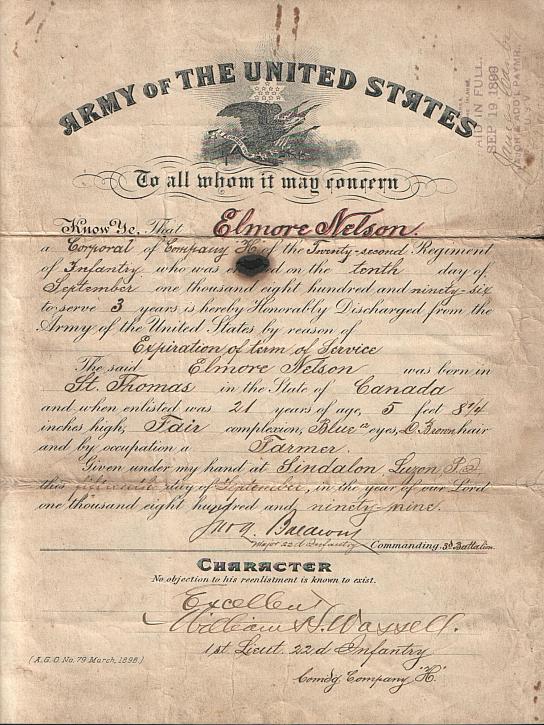
Elmore Nelson's discharge from the US
Army,
signed by his Company Commander, William H. Wassell
1st Lieutenant commanding Company H 22d Infantry
Courtesy of William Bosque
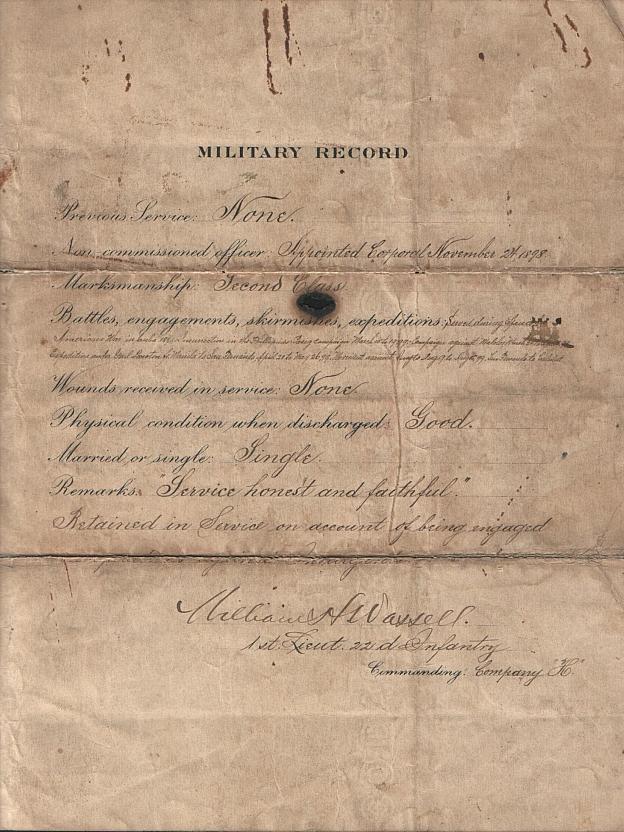
Elmore Nelson's Military Record
noting his service in Cuba and the Philippines
Under Battles & Skirmishes are listed:
Served during Spanish American War in Cuba 1898
Insurrection in the Philippines:
Pasig Campaign March 10 to 19 '99
Campaign against Malolos March '99
Expedition under Gen. Lawton from Manila to San Fernando April 21 to May 26 '99
Movement against Luago Aug 9 to Aug 15 '99
San Fernando to Balacat
Courtesy of William Bosque
...Elmore decided to buy some
land in the Philippines (San Isidro to farm). The farm did
not fair too well so he left for Manila.
While in Manila he met and consequently married Pilar Almeida
Reyes, a Spanish-Portuguese.
They had one daughter, Maria Antonia (our mother). In Manila
Elmore worked as a Patrolman.
Many years later on, Elmore decided to return with his family to
the US. He tried to settle in his hometown of Flint
Michigan.
His wife could not get used to the bitter cold of
Michigan, So Elmore sold his grocery store and moved to Portland,
Oregon.
Seeing his wife unhappy, he decided to take them back to
the Philippines. He started a Sand, gravel, brokerage
business and prospered.
His daughter Maria Antonia married a prominent Spanish
businessman named Miguel Garcia Bosque.
Elmore Nelson had 6
grandchildren, Elena, Jose, Michael Jr., Teresa, Caroline and
William, and numerous Great-Grandchildren.
Still living are Teresa G. B. Howes of Sydney, Australia,
Caroline Rueda and William Bosque of California, USA.
There are also 3 nieces still living: Berneda Smith, Thelma
Henderson and Doris Miller, all in the USA. (April 2006)
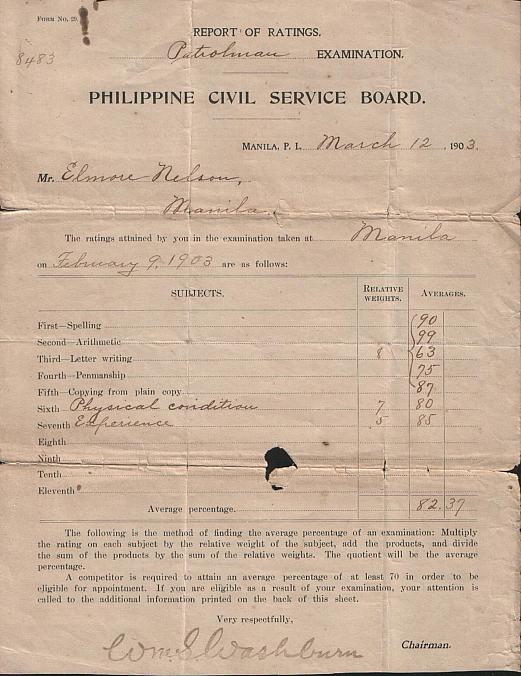
Elmore's ratings report for the Philippine Patrolman Examination
Courtesy of William Bosque
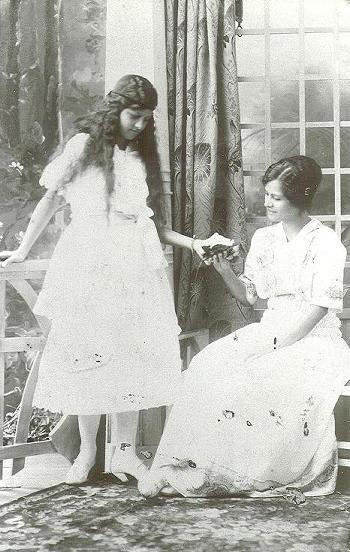
Left, Elmore's daughter Maria Antonia (Toni) - Right, Elmore's wife Pilar
Courtesy of William Bosque
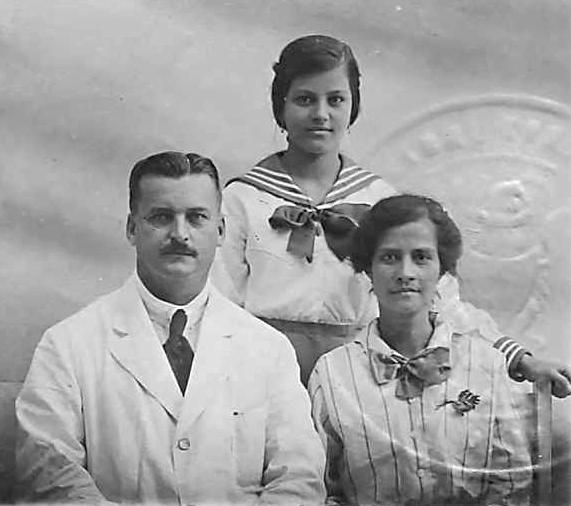
Left to right: Elmore, Antonia and Pilar
From Elmore's application for a passport in August 1917.
The name on his passport was Herman
Elmore Nelson.
His occupation was listed as Public Works Contractor
residing in Manila, Philippine Islands.
From:U.S. Passport Applications, Hawaii,
Puerto Rico and Philippines, 1907-1925 ;
Volume #: Volume 28: Passport Applications-
Philippine Islands
via Ancestry.com
Sometime between December
1926 and November 1928, Elmore, finding himself going blind and
having complications with his hernia,
wanting to see his Parents one more time, his Father Alex Nelson
and his mother Caroline Philpott Nelson,
he came back to the United States leaving his wife Pilar in the
care of his daughter, Maria Antonia,
who was then married and had a family. Elmore put himself in the
care of close friends, Col. and Eva Clyatt.
Elmore was so liked and appreciated by the Clyatts, that they
took care of him until he was forced to enter the Bay Pines
Veterans Hospital in 1937.
His health was deteriorating faster than anticipated........he
had applied for hospitalization on January 19, 1932.
Since the discharge, the rupture in the groin increased and in
1933 it is in extreme development.
His pension was then reduced,
from $40 per month to $15 per month,and he found himself having
to plead for help from the Government.
His daughter and wife were not aware of his health and
financial problems as Elmore elected to keep them in the dark.
Elmore passed away in Florida on March 15, 1938, due to
complications of his war related injuries.
We never found out whether his pension was reinstated again.
We were only able to learn about his financial
and health problems sometime in 1946,
once we were able to re-establish communications with his niece
Berneda.
Only a month ago, Berneda, now pushing on her 90's discovered
that she had these documents of Elmore.
--------------------------------------- William Bosque, April 2006
Home | Photos | Battles & History | Current |
Rosters & Reports | Medal of Honor | Killed
in Action |
Personnel Locator | Commanders | Station
List | Campaigns |
Honors | Insignia & Memorabilia | 4-42
Artillery | Taps |
What's New | Editorial | Links |